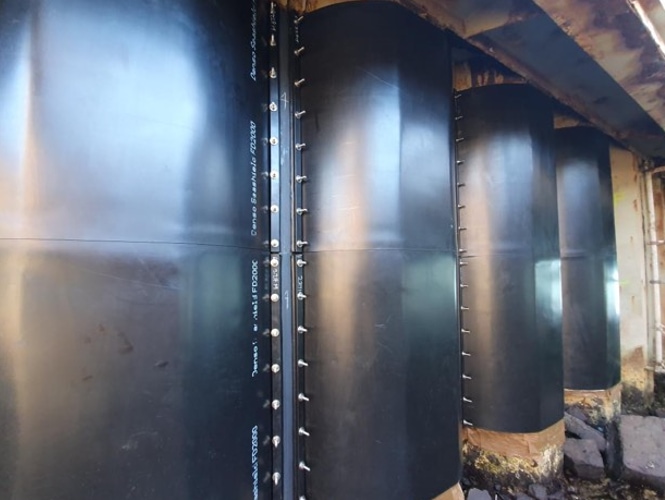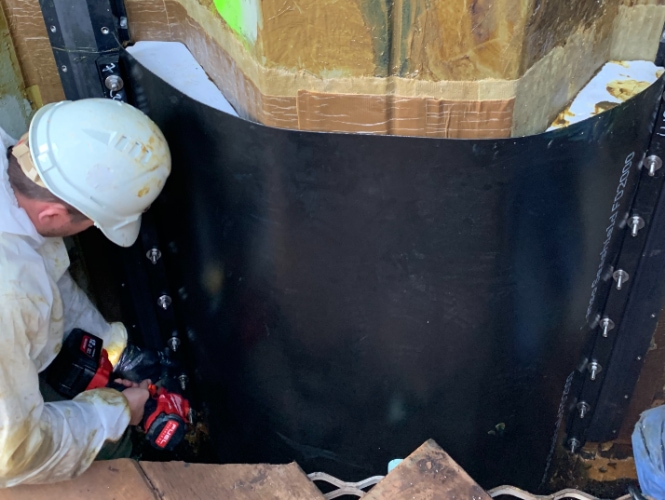Sheet Pile Wall Protection with Denso SeaShield 2020SP™–
A Petrolatum System for Sheet Pile Walls
David Edelman1 and Kyle Fortune2
1 Edelman Projects Pty Ltd, Melbourne, Australia; David@edelman.net.au
2 Denso (Australia) Pty Ltd, Melbourne, Australia
Summary
A corrosion protection system using petrolatum tape has been developed for use on marine sheet pile walls. It has been developed in Australia and tested in-situ at three ports over a period of two years, and by accelerated mechanical testing. The trials show that the system provides exclusion of water and oxygen to the steel surface and therefore excellent corrosion protection. The system is expected to provide protection for 25+ years and will be of interest to port asset managers, designers, and marine contractors.
Introduction
Corrosion protection systems utilising petrolatum tapes have a record of over 50 years of use on marine piles [1]. The petrolatum primers and tapes exclude oxygen from the steel surface while a tensioned outer covering ensures the tape is pressed against the steel surface. These systems provide excellent performance, simple installation including tolerance of heavily pitted surfaces, and long-term cost savings [2].
The authors have developed and tested a corrosion protection system for steel sheet pile walls that uses petrolatum tape and primer and a tensioned outer covering. The new system is available and is being marketed under the name Denso SeaShield™ 2020SP.
System description
The completed system and installation are shown in Figures 1 and 2. The SeaShield™ 2020SP system consists of:
- Petrolatum primer, tapes, and mastic;
- Outer coverings constructed of High Density Polyethylene (HDPE);
- Wall anchor elements (spines) that are constructed of HDPE and fixed to the sheet pile wall by welding or fasteners;
- Rigid foam blocks for profiling the path of the outer covering; and
- Components for protection of tie backs and other elements.
During installation, the outer covering is tightly tensioned and thus presses and retains the petrolatum tape against the steel surface. The outer covering is the same design as that used on discrete piles in the popular SeaShield™ 2000FD system used worldwide. The rigid foam is of the same type used to reprofile the shape of H-piles and hexagonal piles with that system. These elements thus have a proven, successful history of use in the marine environment [1].
The system is generally targeted for protecting steel structures in the splash zone extending from below mid-tide level up to the capping beam or top of the sheet pile wall. The lower extent of the system can be installed during low tides. Asset owners may install a cathodic protection system for protection of submerged sections from mid-tide level to the seabed. This system is therefore complimentary to cathodic protection systems. However underwater application is also effective and may be economically employed in lieu of or in addition to cathodic protection for protection of lower areas. Underwater application has been demonstrated for working depths up to 0.5m. Application at deeper depths is expected to be achievable though is yet to be demonstrated.
In-situ system trials
The system has been trialled at three locations around Australia: Port of Melbourne in Victoria; Port of Townsville in Queensland; and Geraldton Port in Western Australia. These trials ran for a period of up to two years.
Evaluation of these trials focused on determining whether water ingress had occurred between the petrolatum tape and the steel surface or whether degradation or dislocation on the outside of the tape due to water action was evident.
As it is not feasible to carry out a 25+ year trial of the system, this approach to evaluation is reliant on the successful case history of the SeaShield™ 2000FD system and petrolatum wrapping systems generally. Where it can be demonstrated that the arrangement of the system sufficiently protects the tape and retains it against the steel surface then the expectation from that case history is that long-term corrosion protection will be achieved. Conversely, if the trials were to reveal ingress of water to the steel surface, then the corrosion protection would be deemed to not be sufficiently effective in that area, even if no corrosion was evident over the trial period.
Results of the trials showed that the system is highly effective in retaining the tape against the steel surface and protecting the petrolatum tape from water movement or dislocation. Removal of petrolatum tape on the trials revealed that the primer applied underneath the tape was still in place and the tape was still adhered to the wall, showing that water ingress underneath the tape had been effectively prevented. Therefore, the authors expect the system to provide highly effective corrosion protection for the specified life.
The trials were also used for developing and evaluating a number of wall attachment methods for the system as well as parts for the protection of tie-backs.
Mechanical testing
A mechanical testing apparatus was developed to simulate the loads imposed on the wall attachment elements during installation and due to thermal cycling over the life of the system. The apparatus uses one set of pneumatic cylinders to apply the jacket tension load that the system would experience upon installation and a further set of pneumatic cylinders to simulate the loads that would be imposed by thermal expansion and contraction of the spine. Up 3 thermal cycles per day coinciding with tides and day/night cycle are expected. The apparatus was used to confirm the adopted attachment methods performed over a simulated life of over 50 years with 3 full thermal cycles per day, and that it could withstand loads imposed up to double those expected in-situ.
Conclusion
The Denso SeaShield™ 2020SP System has been extensively tested and shown to be effective and durable. The system will be of interest to port asset managers, designers and marine contractors needing long term protection on sheet pile wall assets.
References
1] Smith M, Bowley C, and Williams L. (2002), In-Situ Protection of Splash Zones – 30 Years on, Paper presented at the CORROSION 2002, Denver, Colorado, April 2002.
[2] Edelman D. (2017), Project profile: Lucinda Bulk Sugar Terminal, Corrosion and Materials, November 2017 pp 82 – 85.

Figure 1. Completed system on a sheet pile wall.

Figure 2. (1) Installation of the system; (2) note the petrolatum tape and rigid foam; (3) the worker is tensioning the outer covering.

Figure 3. (1) Cross-sectional shape of the system; (2) the outer covering is tensioned between wall anchor elements over shaped rigid foam blocks; (3) the resulting hoop tension provides a pressure to retain the tape against the steel surface.

Figure 4. (1) Inspection of a trial after 2 years; (2) the outer covering, foam blocks and petrolatum tape have been removed for inspection of the steel surface; and (3) the petrolatum primer is still in place on the steel surface and water ingress has not occurred.

Figure 1. Completed system on a sheet pile wall.

Figure 2. (1) Installation of the system; (2) note the petrolatum tape and rigid foam; (3) the worker is tensioning the outer covering.

Figure 3. (1) Cross-sectional shape of the system; (2) the outer covering is tensioned between wall anchor elements over shaped rigid foam blocks; (3) the resulting hoop tension provides a pressure to retain the tape against the steel surface.



